Greenhouse farming in Kenya has become an essential practice for enhancing crop production and ensuring year-round harvests. As farmers embrace advanced agricultural technologies to maximize yields, environmental control within greenhouses has proven to be one of the key factors influencing success. One of the most critical components of environmental control is humidity management, which can be efficiently monitored and regulated using hygrometers.
Hygrometers are devices that measure the level of humidity in the air, providing accurate real-time data on moisture levels in the greenhouse. In a country like Kenya, where varying weather conditions and unpredictable rainfall can impact crop growth, maintaining optimal humidity levels is vital to ensuring healthy plant development, pest control and efficient water usage.
This article explores how hygrometers help improve greenhouse yields in Kenya, with specific focus on their importance in managing microclimates, enhancing crop health, and optimizing resource usage.
The Importance of Humidity Control in Greenhouse Farming
Greenhouses create controlled environments where farmers can grow crops without being affected by external weather conditions. However, the internal conditions of the greenhouse – especially humidity must be carefully monitored to ensure optimal crop performance.
Here are the key reasons why humidity control is critical in greenhouse farming:
- Regulating Plant Growth:
- The humidity level inside a greenhouse directly affects plant transpiration and water uptake. If humidity levels are too high, plants may absorb less water through their roots, slowing their growth. On the other hand, if humidity is too low, plants may lose water rapidly through transpiration, leading to dehydration. Maintaining the right balance of humidity ensures that crops grow at their maximum potential.
- Preventing Fungal Diseases:
- Excessive humidity in greenhouses can lead to the growth of mold, mildew, and other fungal diseases, which can devastate crops. For example, common fungal diseases such as powdery mildew and botrytis (grey mold) thrive in humid conditions. Using hygrometers allows farmers to keep humidity levels within a safe range to prevent the spread of these harmful diseases.
- Optimizing Photosynthesis:
- Humidity plays a role in the rate of photosynthesis in plants. When humidity levels are too low, plants lose water through their leaves (a process called transpiration), which can hinder the photosynthesis process and slow plant growth. By ensuring that humidity levels remain stable, farmers can promote healthy photosynthesis, leading to stronger, healthier plants.
Ideal Humidity Levels for Greenhouse Crops
The ideal humidity levels for greenhouses vary depending on the type of crop being grown. However, in general, most greenhouse crops in Kenya thrive at relative humidity levels between 50% and 70%. Maintaining this range ensures optimal transpiration, reduces the risk of disease, and promotes healthy plant growth.
- Low Humidity: If humidity drops below 50%, plants may experience increased transpiration, leading to wilting and dehydration. This can result in stunted growth, reduced yield, and poorer quality produce.
- High Humidity: If humidity exceeds 70%, plants may absorb less water through their roots, which can slow down their growth. High humidity also increases the risk of fungal infections and pest infestations, which can destroy entire crops.
How Hygrometers Improve Greenhouse Yields in Kenya
1. Monitoring and Controlling Microclimates
Kenya’s diverse climatic regions require farmers to be precise in managing greenhouse environments. Even within the greenhouse, microclimates may form, with temperature and humidity varying from one section to another. Using a network of hygrometers allows farmers to monitor humidity levels in different parts of the greenhouse, ensuring uniform conditions.
- ThermoPro TP357: This smart WiFi hygrometer is an excellent tool for monitoring microclimates in large greenhouses. It transmits real-time humidity data to the ThermoPro Sensor App, allowing farmers to track conditions in multiple zones and make necessary adjustments to maintain optimal growing conditions.
2. Reducing Water Usage
In Kenya, water is a scarce and valuable resource, especially in areas prone to drought. By using hygrometers, farmers can optimize water usage in their greenhouses. When humidity levels are monitored in real time, farmers can avoid over-irrigating crops, which not only conserves water but also prevents conditions that can lead to root rot and other diseases.
- ThermoPro TP49: This compact hygrometer provides accurate readings of current humidity levels, helping farmers make informed decisions about irrigation schedules. By knowing the exact humidity inside the greenhouse, they can reduce water wastage while ensuring plants receive the right amount of moisture.
3. Preventing Disease Outbreaks
One of the biggest challenges facing greenhouse farmers in Kenya is the spread of fungal diseases, which thrive in overly humid environments. Hygrometers allow farmers to monitor humidity levels and take proactive steps to prevent the spread of diseases such as downy mildew, fusarium wilt, and botrytis.
- ThermoPro TP60C: This wireless hygrometer is perfect for larger greenhouses. Its waterproof design allows it to be used in humid environments, and its long-range monitoring capabilities help farmers track humidity in real time, preventing the conditions that lead to disease outbreaks.
4. Optimizing Growth for Specific Crops
Different crops require different humidity levels for optimal growth. By using hygrometers, farmers can tailor their greenhouse environments to meet the specific needs of their crops. For example, leafy greens like spinach and kale thrive in slightly higher humidity levels, while crops like tomatoes and peppers require drier conditions to prevent fungal infections.
- ThermoPro TP90: This WiFi-enabled hygrometer allows farmers to adjust humidity levels for specific crops. The ability to remotely monitor humidity using the mobile app ensures that conditions can be optimized even when the farmer is not on-site.
5. Improving Yields for Mushroom Farming
Mushroom farming is a lucrative industry in Kenya, but it requires very specific environmental conditions to succeed. Mushrooms thrive in high-humidity environments, and even slight variations in humidity levels can affect their growth. By using hygrometers, mushroom farmers can monitor and maintain the ideal conditions needed for optimal yields.
- ThermoPro TP200B: This waterproof hygrometer is ideal for mushroom farms, which require consistent humidity levels. Its durability and accuracy make it perfect for ensuring that humidity remains stable, which is critical for mushroom growth and yield.
The Role of Hygrometers in Controlling Pests in Greenhouses
In addition to regulating plant growth, humidity levels also play a role in pest control. Certain pests, such as aphids and spider mites, thrive in dry conditions. On the other hand, high humidity can encourage the spread of fungal diseases that indirectly promote pest infestations. By maintaining ideal humidity levels through the use of hygrometers, farmers can reduce the likelihood of pest outbreaks, minimizing the need for chemical pesticides.
- ThermoPro TP358: This smart hygrometer with a backlit display makes it easy for farmers to monitor humidity levels even at night. By ensuring that humidity remains within the ideal range, farmers can prevent pest infestations and reduce crop damage.
Economic Benefits of Using Hygrometers in Greenhouse Farming
- Increased Yields:
- By maintaining the right humidity levels, farmers can significantly increase their crop yields. Healthy plants that are free from disease and pests are more likely to produce higher-quality fruits and vegetables.
- Cost Savings:
- Hygrometers help farmers save money by reducing water usage and minimizing the need for fungicides and pesticides. Precise humidity control also extends the lifespan of greenhouse structures and equipment by preventing the buildup of moisture that can lead to corrosion and mold.
- Sustainability:
- As Kenya faces increasing environmental challenges such as water shortages and climate change, greenhouse farmers can use hygrometers to adopt more sustainable practices. By conserving water and reducing chemical inputs, they contribute to more environmentally friendly agricultural practices.
Greenhouse farming offers a solution to the challenges posed by Kenya’s unpredictable climate, but to maximize the benefits, farmers must maintain strict control over the growing environment. Hygrometers provide an effective way to monitor and regulate humidity, ensuring that crops receive the right amount of moisture for optimal growth.
Whether it’s preventing disease, reducing water usage, or optimizing conditions for crops like tomatoes, spinach, and mushrooms, hygrometers play a critical role in improving yields and ensuring sustainable farming practices. By investing in high-quality hygrometers such as the ThermoPro TP90 or the ThermoPro TP60C, Kenyan greenhouse farmers can take full advantage of advanced agricultural technology to improve their productivity and profitability.

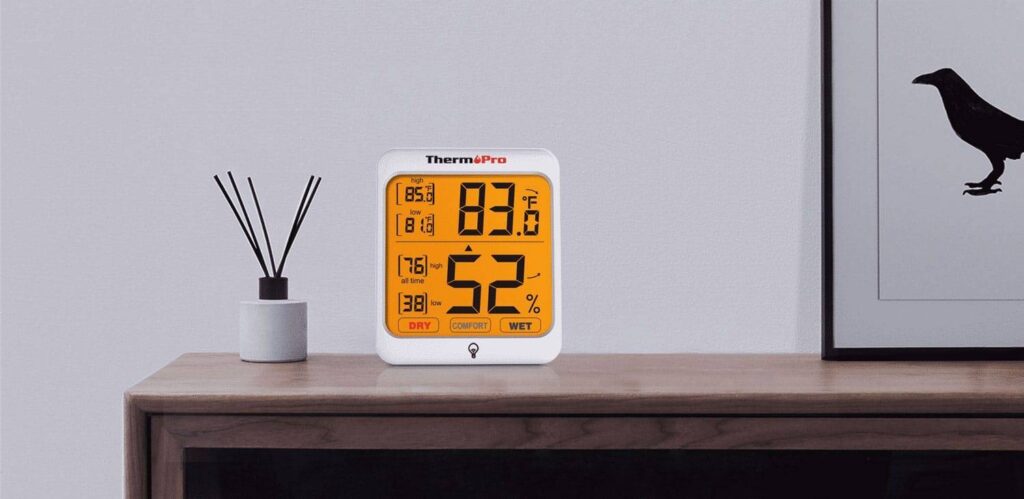
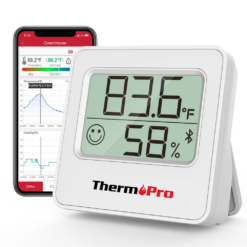
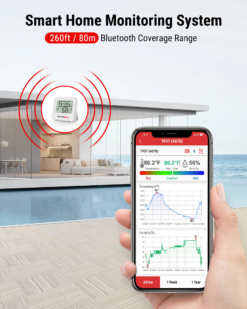
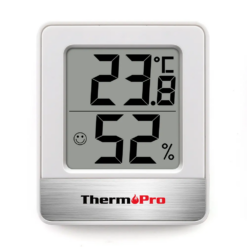
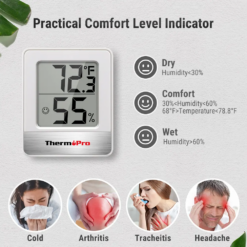
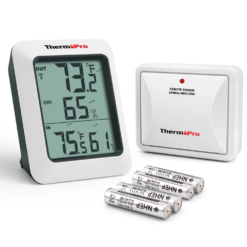
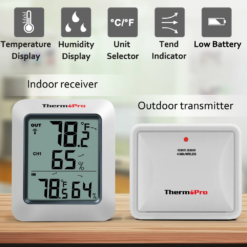
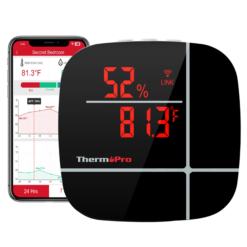

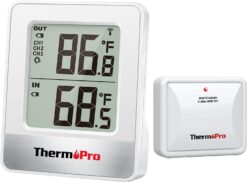
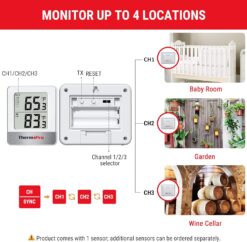
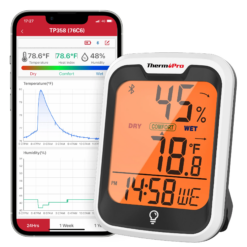
Pingback: How To Position The Thermopro TP49 for Accuracy in Kenya